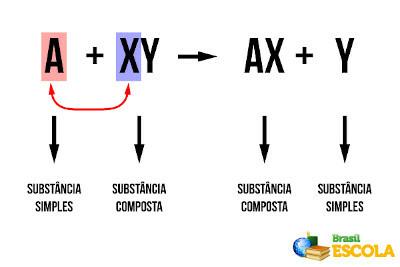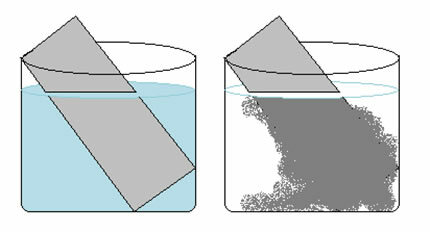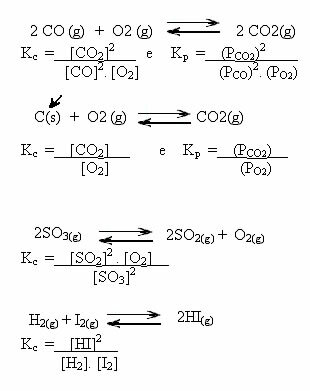The concentration of solutions corresponds to the amount of solute present in a given amount of solvent.
When we refer to concentration, we are interested in discovering the relationship between the amount of solute and solvent in a solution.
There are several ways to calculate the concentration of a solution and different measurement units can be used.
Types and Ways to Calculate Concentration
common concentration
The common concentration is the relationship established between the mass of the solute and the volume of the solution.
It is expressed through the following formula:
C = m / V
Where:
C = common concentration, in g/L
m = mass of solute, in g
V = volume of solution, in L
Don't confuse common concentration with density, which relates the mass and volume of the solution. Density is calculated as follows:
d = m / V
d = density, in g/L
m = mass of solution (mass of solute + mass of solvent), in g
v = volume of solution, in L
Molar Concentration or Molarity
The molar concentration or molarity is the relationship between the mass of solute in number of moles and the volume of a solution.
Molarity is expressed through the following formulas:
M = n1 / V or M = m / M1.V
Where:
M = molarity, in mols/L
n1 = number of mols of the solute, in mol
m = mass of solute, in g
M1 = molar mass, in g/mol
V = volume of solution, in L
read about Number of Mol and Molar Mass.
Title Concentration
The titer or mass percentage of the solution is the ratio between the mass of the solute and the mass of the solution.
It is expressed using the following formula:
T = m1 / m or T = m1 / m1 + m2
Where:
T = title
m = mass of the solution, in g
m1 = mass of solute, in g
m2 = mass of solvent, in g
The title does not have a unit of measure, being expressed, in most cases, as a percentage. For this, the result achieved must be multiplied by 100: % = 100. T
When the solution is gaseous or just liquid, the titer can also be calculated from the volume of the solution, substituting mass values for volume. However, it is not possible to add the volume of solvent and solute.
T = V1/V
parts per million
In some cases, the mass of solute present in the solution is extremely small, making it impossible to calculate the percentage.
One possibility is to calculate the amount of solute, in grams, present in 1,000,000 (106) grams of solution.
The formula for this calculation is as follows:
1 ppm = 1 part solute / 106 of solution
Molality
THE molality or molal concentration expresses the amount and number of moles of solute present in the solvent.
W = 1000. m1 / m2. M1
Where:
W: Molality, in mol/kg
m1: mass of solute
m2: mass of solvent, in kg
M1: molar mass of solute
Relationship between concentrations
In addition to the forms presented, it is also possible to calculate the concentration from the relationship between the common concentration, density and titer.
The formula to be used is as follows:
C = 1000. d. T
Where:
C = common concentration
d = density
T = title
Know more:
- Chemical Solutions
- Solute and Solvent
- Solubility
- Dilution of solutions
Solved Exercises
1.(UFSCAR - SP) Saline contains 0.900 grams of NaCℓ, molar mass=58.5 g/mol, in 100 mL of aqueous solution. The concentration of saline, expressed in mol/L, is equal to:
a) 0.009
b) 0.015
c) 0.100
d) 0.154
e) 0.900
Resolution:
Observing the data provided by the question, you should use the molarity formula.
Also, don't forget to transform the 100 mL of the solution into liters, resulting in 0.1 L.
M = m / M1.V
M = 0.900 / 58.5. 0,1
M = 0.154 mol/L
Reply: Alternative d) 0.154
2. 24g of sucrose is dissolved in enough water for 500 ml of solution. What is the common concentration of this solution?
Resolution:
From the formula for common concentration, we have C = 24 / 0.5.
Note that it was necessary to transform 500 mL to liters.
Reply: Common concentration equal to 48 g/L.
Exercises
1. (Vunesp-2000) Knowing that the molar mass of lithium is 7.0g/mol, the mass of lithium contained in 250mL of an aqueous solution with a concentration of 0.160mol/L of lithium carbonate is:
a) 0.560g.
b) 0.400g.
c) 0.280g.
d) 0.160g.
e) 0.080g.
a) 0.560g.
2. (UCS-RS) One person used 34.2g of sucrose (C12H22O11) to sweeten their coffee. The volume of sweetened coffee in the cup was 50 mL. The molar concentration of sucrose in the coffee was:
a) 0.5 mol/L.
b) 1.0 mol/L.
c) 1.5 mol/L.
d) 2.0 mol/L.
e) 2.5 mol/L.
d) 2.0 mol/L.
3. (PUC - RS/1-2000) Normal saline is an aqueous solution of sodium chloride, used in medicine because its composition coincides with that of body fluids. Knowing that it was prepared by dissolving 0.9g of the salt in 100 mL of solution, we can say that the molarity of the solution is, approximately:
a) 1.25.
b) 0.50.
c) 0.45.
d) 0.30.
e) 0.15.
e) 0.15.



